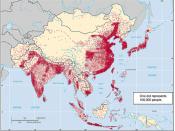The Republic of Singapore is an independent nation in Southeast Asia, located off the tip of the Malay Peninsula and connected to Malaysia by causeway. Formerly a British crown colony and then part of the Federation of Malaysia, it became independent in 1965. The name Singa Pur (Sanskrit for "city of the lion") was given by Sumatran settlers in the 13th century. It is a densely populated and prosperous nation whose people enjoy one of the highest standards of living in Asia. Singapore Island accounts for 93% of the total land area of 617.8 km6 (238.5 mi6); the remaining 7% is composed of 50 small islets. The islands are generally flat. The highest point is located near the center of Singapore Island. The island is drained by several short rivers and streams, the longest of which is Seletar River, about 14.5 km (9 mi) long. Located about 110 km (70 mi) north of the equator, the nation has a tropical, wet climate.
The average temperature in January is 26á C (79á F) and in July, 28á C (82á F); rainfall totals 2,413 mm (95 in) annually. Since Singapore lies almost on the equator, its temperature and precipitation are distributed quite evenly throughout the year. Singapore's principal resources are its strategic position, on the Singapore Strait, and its people. Natural vegetation once consisted of forests and mangroves, but today only 5% of the land area is tree covered. Singapore is a multiethnic nation. Approximately 76% of their population is Chinese, 15% Malay, and 9% Indian, Pakistani, Sri Lankan, and others. English, the principal language of business, government, and education, is used by more than 25% of the adult population. Religious affiliation reflects ethnic background. Most Chinese are Buddhist or Daoism (Taoist); Malays and Pakistanis, Muslim; most Indians, Hindu; and others,


